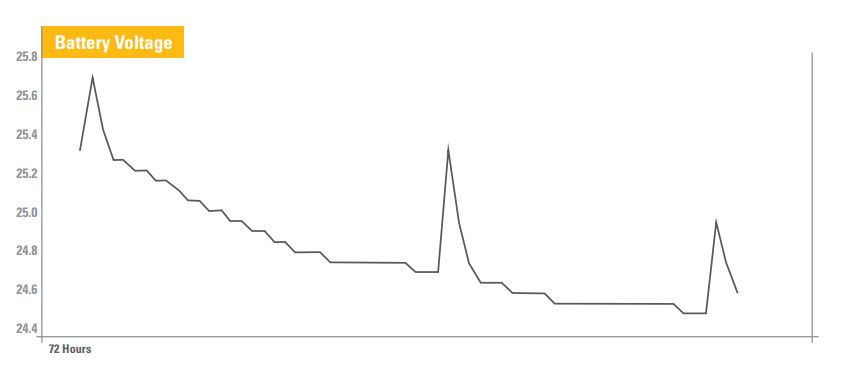"Not Ready to Run Event" Diagnosed and Resolved
What Happened?
An offshore dealer engaged in a field follow program with a customer was experiencing a “Not Ready to Run Event” on a standby gen set. A “Not Ready to Run Event” occurs when an engine is incapable of running under current conditions. In this case, the engine could not run because of an alternator failure. Cat® E&T TES used remote monitoring technology to identify the problem and diagnose its underlying cause. Then a strategy was recommended to resolve the issue and prevent future failures.
What Was the Underlying Cause?
The customer was operating the standby gen set consistently every day for five minutes. Each start required a big ampere draw. A five-minute run time was not sufficient to replace the charge on the battery. As a result, voltage was draining over time as the engine cycled through its start-run-stop schedule (see screen shot). This ultimately led to an alternator failure which caused the “Not Ready to Run Event.” The alternator was repaired, but the customer continued to use a five-minute engine run schedule so the problem persisted. The E&T TES team used Product Link Web to view data from the standby generator and study the effects of declining voltage. The team concluded that a longer start-run-stop schedule was necessary in order for battery voltage to increase to a normal level. The team sent an alert, advising the customer to run the engine for a longer period of time. The recommendation was followed. Voltage returned to normal after the engine ran for 30 minutes.
What Was the Value to the Customer?
Using data collected from the standby gen set, the E&T TES team was able to predict asset behavior, develop a strategy for preventing premature failure and avoid unexpected downtime. Preventing future failures helps reduce the customer’s total costs, including the cost of downtime, parts and labor. Other cost savings may also be generated by continuing to adjust the engine start-run-stop cycle to optimize operator time, fuel consumption and costs, based on battery size, condition and other factors. There may also be an opportunity for Caterpillar engineers to use the data to design battery backup systems that further improve the health and life of the gen set and its battery

